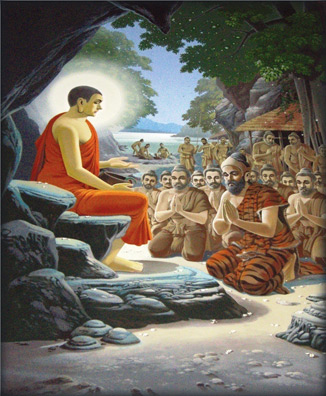|
 Vap Full Moon Poya Day falls on Wednesday: Vap Full Moon Poya Day falls on Wednesday:
Impermanence: the Buddhist view of life
By Lionel Wijesiri
Most of us think the impermanence of all things is an unpleasant fact
we’d rather ignore. We look at the world around us, and most of it seems
solid and fixed. We tend to stay in places we find comfortable and safe,
and we don’t want them to change. We also think we are permanent, the
same person continuing from birth to death, and maybe beyond that.
In other words, we may know, intellectually, that things are
impermanent, but we don’t perceive things that way. And that’s a
problem.
Trilalakshana
Buddha teaches us that there are the three characteristics (trilalakshana)
of all that is conditioned, i.e., dependently arisen. These three basic
facts of all existence are:
Impermanence (anicca)
Suffering (dukkha)
Not-self (anatta).
The first and the third apply to non-living beings existence as well,
while the second (suffering) is, of course, only an experience of the
living beings. The non-living beings, however, can be, and very often
is, a cause of suffering for living beings: for instance, a landslide
may cause injury, death to living beings.
It may also cause loss of property and, as a result, mental pain to
living beings. In that sense, the three are common to all that is
conditioned, even to what is below or beyond the normal range of human
perception.
|

Life, according to the Buddha, is suffering or dukkha; and
that suffering is based on ignorance or avijja. |
Existence can be understood only if these three basic facts are
grasped, and not only logically, but in confrontation with one’s own
experience. Insight-wisdom (vipassana) which is the ultimate
enlightening factor in Buddhism, consists just of this experience of the
three characteristics applied to one’s own bodily and mental processes,
and deepened and matured in meditation.
Process
The Buddha teaches that the cosmic process goes through four stages
of development.
(a) It emerges from a state of undifferentiated matter.
(b) It evolves to a point of maximum differentiation.
(c) It begins to disintegrate.
(d) Then it reaches a stage of total disintegration, destruction.
Then after sometime, the process repeats itself. In this way every
world system arises, evolves and passes away. In history we find the
same pattern. A civilisation arises, reaches its zenith, declines and
eventually perishes.
In life, we are born and grow up, when growth reaches the maximum it
is followed by ageing decay and death. Nothing in life is absolutely
reliable. Fortune changes, character and relationships evolve and
dissolve. That is the coarse feature of impermanence.
The subtle mark of impermanence is more difficult to grasp. The
Buddha points out that there are no static entities, but only dynamic
processes which appear to us to be stable and static only because our
perception is not sharp enough to detect the changes. Things themselves
are constantly undergoing changes just as a waterfall is always changing
but from a distance it seems solid, because we can’t perceive the flow.
The Buddha taught that when we die we are reborn in a new form but he
doesn’t want us to see this as an essential or self, moving from one
vehicle (the body) to another. In one Buddhist scripture, it is
described in the following way:
What happens from life to life is a constant evolving for better or
worse, (depending on our actions). Just as we are not the same person as
an adult that we were as a child, so we change from life to life, the
quality of our circumstances determined by our previous actions.
Within each personality there is ability to make decisions which are
like a rudder directing the course of our lives. The decisions we make
can be good or bad, but we have that freedom.
The impermanence of life becomes self-evident to those who are
mindful of their inner and outer worlds. Through the practice of
mindfulness meditation they arrive at the definitive conclusion that
suffering is inevitable for those who are caught in the dualities of
attraction and aversion to transient phenomena.
Buddhism therefore prescribes mindfulness practice to overcome the
negative influence of impermanence.
Mindfulness
In this regard, out of the two methods of mindfulness meditation
prescribed by the Buddha, vipassana meditation is considered the best.
Vipassana meditation is an awareness meditation. It teaches us to be
aware of everything that comes to us and is happening to us.
Only the present moment is important. And everything that comes to us
at the present moment through the six sense doors is to be noted, to be
watched, to be observed as the object of awareness.
When we practise Vipassana meditation, by making mental notes or just
watching the various things that come to us, we will bring awareness to
a high level so that we will be able to see things as they truly are. We
will come to see the true nature of mind and body. “True nature” means
the nature of impermanence, the nature of dukka, and the nature of
anatta.
|

The Buddha taught His disciples that the cosmic process goes
through four stages of development and keep repeating. |
It is important to see these three characteristics of nature so that
we can have a correct view of things, and may have less attachment to
mind and body. Gradually we will be able to weaken the hold of mental
defilements that prevent enlightenment.
We may see the three stages of existence: arising, staying for a time
and then disappearing. They are known as the three sub-moments of one
thought moment. When we see a state of mind arise, stay for a very short
time, and then disappear, we know that this is impermanent.
This knowing or seeing that something is impermanent, must come from
our own experience. It must not come from a book, it must not come from
a teacher. It must come from within ourselves. So we must not be
satisfied with what we read in books or hear in talks. We must see for
ourselves.
In Vipassana meditation, which is also called insightful meditation,
we gain insight into the nature of our existence as we pay mindful
attention to the impermanence that is inherent in the various aspects of
our own personality, namely, our breathing, feelings and sensations,
consciousness and the sense-objects or the phenomena. As we become aware
of how they appear and disappear like the waves in an ocean, we develop
“clear seeing” and tranquil awareness (jhana).
Real life
The ignorance on our mind stream blots out impermanence, and we have
a lot of grasping to things being permanent. Of course intellectually we
say, “Yes! Yes! Everybody dies and my antiques break and the car
breaks…” We say it all intellectually but that is just intellectual.
We just can’t accept it when it happens. That shows that there is a
big difference between intellectually knowing something and actually
integrating it in our lives so that it becomes our way of relating to
the world. It’s showing that intellectually knowing something doesn’t do
the trick of solving our problems. We have to put it in our heart.
Impermanence is the nature of our existence. We cannot fight with it
or escape from it as long as we are caught in the cycle of births and
deaths. We cannot remove impermanence from existence, but we can gain an
insight into working and learn to deal with it by controlling our
emotions and attitudes, until we reach a stage where it is no more
troublesome for us. |

